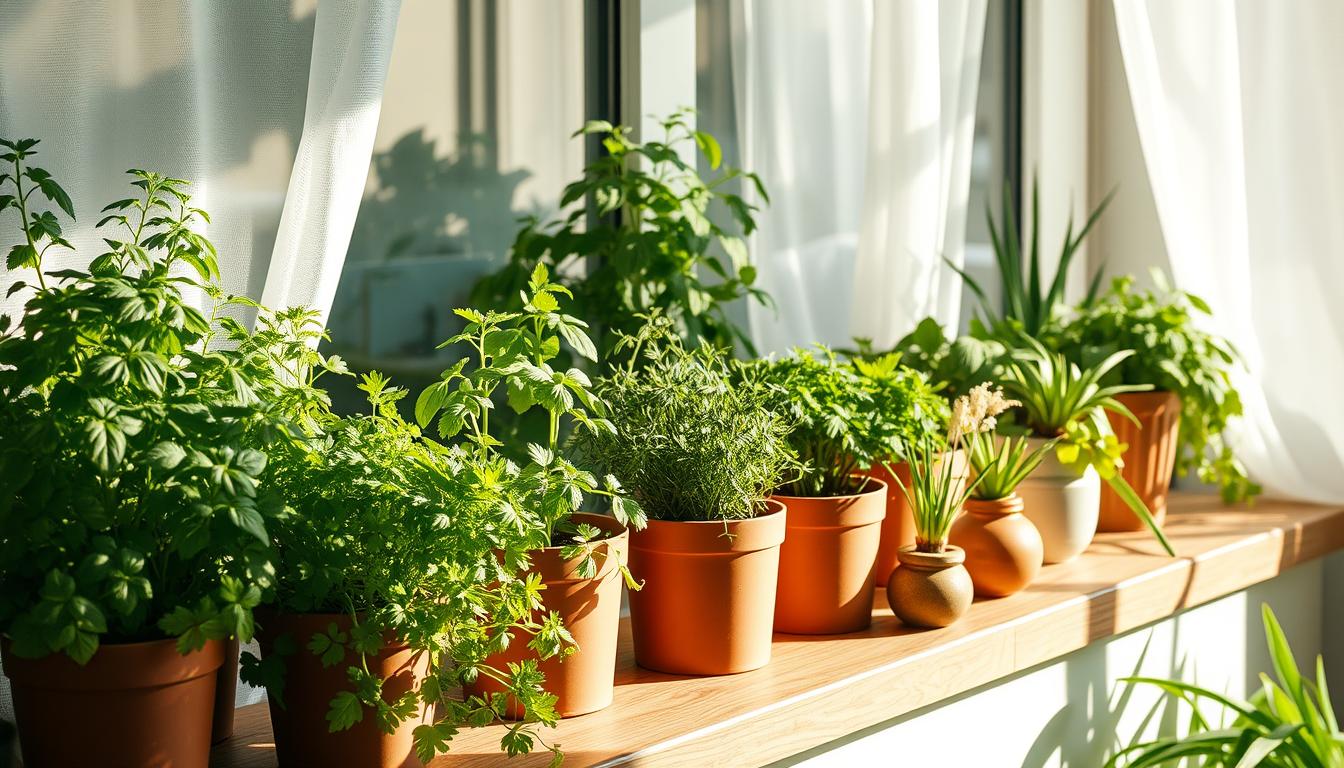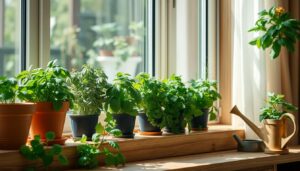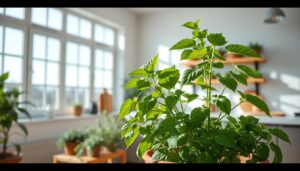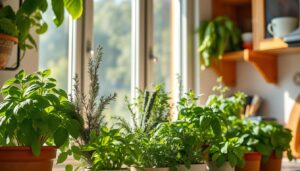Did you know over 50% of U.S. households now have at least one indoor plant? This trend shows our love for low-maintenance herbs that do well in limited light. Whether you’re new to gardening or a pro, this guide will show you the top 10 low-light indoor herb plants. These plants can turn your living space into a lush oasis.
Key Takeaways
- Discover the best low-light herbs for indoor cultivation
- Learn about the importance of sunlight for plant growth and how some herbs adapt to low-light conditions
- Explore versatile and flavorful options like mint, parsley, cilantro, and more
- Understand the benefits of growing edible houseplants in your home
- Get tips on windowsill gardening and maintaining healthy indoor herb plants
Importance of Sunlight for Plants
Sunlight is key to life on Earth, especially for plants. It gives them the energy they need to grow and stay healthy. Plants use sunlight to make their own food through photosynthesis. This process is essential for their survival.
Knowing how sunlight affects plant health is important. It helps us understand what plants need to grow well, even in low light.
Plants’ Reliance on Sunlight for Energy
Plants, like all living things, need the sun’s energy to live. They have special parts called chloroplasts that catch sunlight. These chloroplasts turn sunlight into energy for the plant.
Photosynthesis: The Process of Harnessing Sunlight
Photosynthesis is how plants make their own food. They use water and carbon dioxide to create glucose and oxygen. Glucose is the plant’s food, and oxygen is released into the air.
This process is vital for the plant’s growth and health. It gives them the energy they need to grow strong.
Without the sun’s energy, plants couldn’t make the food they need to grow and develop.
Why Some Herbs Thrive in Low-Light Conditions
When growing indoor herb gardens, knowing how shade-loving plants adapt is crucial. Some herbs have developed special ways to use little light well. They make the most of the light they get for photosynthesis.
Adaptations for Efficient Light Absorption
Low-light herbs make more chlorophyll. Chlorophyll is what makes plants green and helps them use light. These herbs have more chlorophyll, so they can use more light and make energy from it.
These herbs also have thinner, larger leaves. This shape lets more light get into the leaf. It makes photosynthesis more efficient.
Thanks to these changes, low-light herbs do well in places where other plants can’t. Knowing about plant adaptations to low light and leaf structure changes in shade plants helps grow a great indoor herb garden.
Mint: The Versatile Low-Light Herb
If you love gardening and want to grow an indoor herb garden, mint is perfect. It’s easy to grow and thrives in low light. This makes it great for those who want fresh, tasty herbs all year.
Peppermint and spearmint are the top types of mint. They do well with just 3-4 hours of sunlight daily. Mint grows fast and is great for containers. This means you can always have fresh leaves for cooking and health remedies.
One big plus of mint indoors is how well it does in low-light mint cultivation. It’s tough and can handle different light levels. This is great for people with little natural light at home.
| Mint Variety | Flavor Profile | Ideal Growing Conditions |
|---|---|---|
| Peppermint | Refreshing, cool, and slightly minty | Partial shade, moist soil |
| Spearmint | Sweet, herbaceous, and mildly minty | Partial shade, well-drained soil |
Looking to spice up your cooking or find a natural cure? Growing mint indoors is a great choice. It’s perfect for indoor gardens because it grows well in low light.
Parsley: A Flavorful and Nutritious Option
If you want to grow a versatile and nutritious herb indoors, parsley is a great pick. It does well in low light, making it ideal for indoor gardens. There are two main types: curly-leaf and flat-leaf (or Italian parsley). Each has its own unique taste.
Curly vs. Flat-Leaf Parsley
Both curly and flat-leaf parsley are edible and nutritious. However, flat-leaf has a stronger, more robust flavor. It’s often used in hearty dishes. Curly-leaf is better for garnishes or lighter recipes.
Growing Parsley from Seed or Cuttings
You can grow parsley from seed or cuttings. Starting from seed takes patience, as it can take weeks to germinate. Cuttings can be rooted in water or soil for a quicker start.
Make sure your parsley has well-draining soil and enough water. This ensures a healthy plant and a good harvest.
Parsley is not just versatile in cooking; it’s also full of vitamins and minerals. It has vitamins A, C, and K, plus iron. Adding it to your meals can make them tastier and healthier.
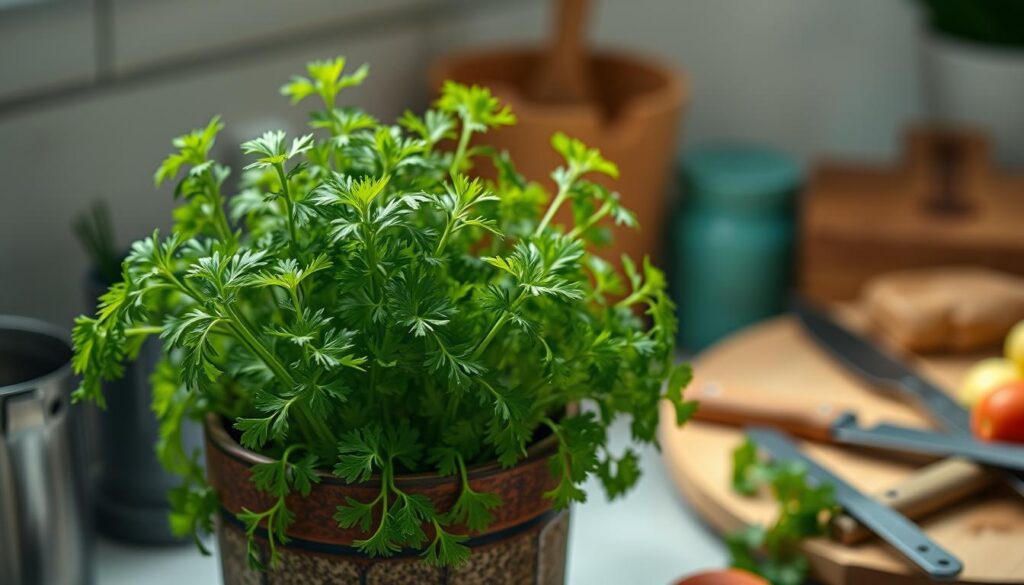
Cilantro: A Flavor-Packed Herb for Low Sodium Dishes
If you want to cut down on sodium but still enjoy tasty food, cilantro is a great pick. This herb, also known as coriander, does well in low light, perfect for indoor gardens. It’s great for those growing herbs indoors or adding its unique taste to meals, making low-sodium cooking more exciting.
Cilantro’s taste is bright, citrusy, and a bit peppery. It can make many dishes better, like salads, salsas, curries, and soups, without needing a lot of salt. Using cilantro can make your meals tasty and keep sodium levels low.
Cilantro also has a practical side for coriander seed harvesting. Let it flower and produce seeds for a steady supply of coriander. This spice is useful in both sweet and savory dishes.
“Cilantro is a game-changer for low-sodium cooking. Its bold, zesty flavor profile can transform even the simplest dish into something truly special.”
For both experienced cooks and beginners in indoor herb gardening, cilantro is a top choice. It thrives in low light, offering its flavorful benefits all year. Adding it to your kitchen herb garden is a must.
Thyme: Adding Savory Notes to Your Dishes
Thyme is a versatile herb that adds a savory touch to many dishes. It grows well in low light, making it perfect for indoor gardens. Discover the different types of thyme, each with its own unique flavor to enhance your cooking.
Common Varieties of Thyme
Learn about the popular thyme varieties for growing thyme indoors and cooking:
- French Thyme: A classic choice, French thyme has a strong, earthy thyme flavor profile. It’s great with meats, stews, and sauces.
- Lemon Thyme: This variety has a bright, citrusy taste. It’s perfect for marinades and dressings.
- Caraway Thyme: Known for its caraway-like scent, it adds a unique thyme flavor to baked goods and roasted vegetables.
Any thyme variety you pick is great for indoor gardens because it grows well in partial shade.
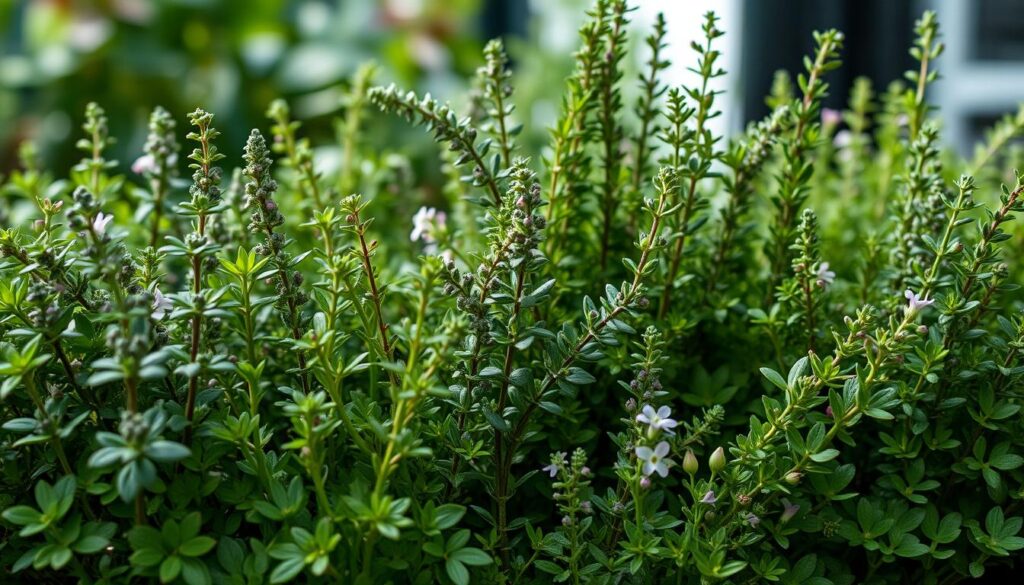
“Thyme is a must-have herb for the savvy home cook, offering a versatile flavor that can elevate a wide range of dishes.”
Chives: Beautiful Edible Ornamentals
Chives are a captivating herb that can thrive indoors, even in low-light conditions. They are not just for cooking; they also look great as edible ornamentals. With their vibrant green foliage and delicate, onion-flavored flowers, they are a treat for the eyes. The two main types are onion chives and garlic chives, which do well in window-sill gardens or containers needing 3-4 hours of sunlight daily.
Chives are great for indoor gardens because they look good and are useful in the kitchen. Growing them indoors lets you enjoy their fresh leaves and flowers all year. This adds a nice touch to your cooking and home decor.
| Chive Variety | Flavor Profile | Appearance |
|---|---|---|
| Onion Chives | Mild, onion-like taste | Thin, hollow green leaves and purple-pink flowers |
| Garlic Chives | Subtle garlic aroma and flavor | Flat, broad green leaves and white flowers |
Choosing between onion chives and garlic chives is a matter of taste. Both are essential for any indoor garden. They add beauty and flavor, making them a delight for everyone.
“Chives are a wonderful addition to any indoor garden, offering both beauty and flavor in one delightful package.”
Low-light indoor herb plants
Not all plants do well in low-light spots inside. But, there are many low-light herbs and shade-tolerant herbs that can do great in your indoor herb garden. They give you a lot of compact kitchen herbs and natural home decor all year.
Herbs like mint, parsley, cilantro, and thyme are great for low-light indoor herb plants. But, you can also try lemon balm, rosemary, and chives. These herbs have special traits that help them grow well in the shade.
| Herb | Sunlight Requirement | Key Features |
|---|---|---|
| Lemon Balm | Partial Shade | Bright green, fragrant leaves; easy to grow from cuttings |
| Rosemary | Partial Shade | Evergreen, aromatic leaves; thrives in containers |
| Chives | Partial Shade | Delicate, onion-flavored leaves; can be grown as ornamentals |
Choosing these low-light herbs lets you make a indoor herb garden that’s always ready. You’ll have fresh, tasty ingredients even in places that don’t get much sunlight.
“Growing your own compact kitchen herbs is a great way to add natural home decor and fresh flavor to your meals, no matter the lighting conditions in your space.”
Lemon Balm: A Refreshing Addition to Your Garden
Lemon balm is a joy to have in any garden, being easy to care for and thriving in low light. Its lemony scent brightens up your cooking and has many uses. Adding it to your indoor garden is a smart choice.
Growing Lemon Balm from Cuttings
Propagating lemon balm is simple and cost-effective. You can grow new plants from cuttings from your existing plants. This way, you keep your herb supply going without buying new seedlings.
This herb loves low light, making it perfect for indoor gardens. It only needs 3-4 hours of sunlight daily to grow well. So, you can always have fresh leaves for your recipes.
“Lemon balm is a refreshing and versatile herb that can thrive in even the most challenging indoor environments. Its lemony aroma and soothing properties make it a delightful addition to any garden.”
Lemon balm is great for adding flavor to dishes or keeping insects away naturally. Growing it indoors means you can enjoy its benefits all year. It’s a rewarding herb to have at home.
Conclusion
Growing low-light herbs indoors is easy and rewarding for gardeners at any level. Choose the right herbs like mint, parsley, cilantro, thyme, chives, and lemon balm. These compact kitchen herbs and natural home decor can thrive in sun-deprived areas of your home. They’re perfect for indoor herb cultivation.
With proper care, you can have fresh, flavorful herbs all year, even without much sunlight. These low-light herb varieties are great at using little light well. Adding them to your home boosts your cooking skills and brings in natural home decor and greenery.
Anyone can enjoy low-light herb gardening. Start growing your own compact kitchen herbs and see the many benefits they bring. They can make your dishes better, clean the air, and make your home feel more welcoming.
FAQ
What are the top 10 low-light herbs to grow indoors?
Why is sunlight important for plants?
How have some herbs adapted to grow in low-light conditions?
Why is mint a great choice for indoor herb gardening?
How can parsley be grown indoors?
What makes cilantro a good choice for low-sodium cooking?
What are the different varieties of thyme that can be grown indoors?
How can chives be used in indoor herb gardens?
What other low-light herbs can be grown indoors?
How can lemon balm be propagated for indoor growing?
Source Links
- The best herbs to grow in low light – https://herbsathome.co/best-herbs-to-grow-in-low-light/
- 5 Low Light Herbs to Grow in Your Kitchen – https://howtoculinaryherbgarden.com/low-light-herbs/
- Growing herbs indoors without sunlight: Let’s make it simple – https://www.livingroomjungle.com/growing-herbs-indoors-without-sunlight-2/


